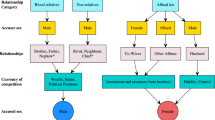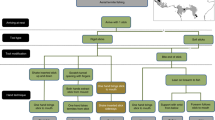Abstract
Anthropologists have long argued that fear of victimization through witchcraft accusations promotes cooperation in small-scale societies1. Others have argued that witchcraft beliefs undermine trust and therefore reduce social cohesion2. However, there are very few, if any, quantified empirical examples demonstrating how witchcraft labels can structure cooperation in real human communities. Here we show a case from a farming community in China where people labelled zhu were thought capable of supernatural activity, particularly poisoning food. The label was usually applied to adult women heads of household and often inherited down the female line. We found that those in zhu households were less likely to give or receive gifts or farm help to or from non-zhu households; nor did they have sexual partnerships or children with those in non-zhu households. However, those in zhu households did preferentially help and reproduce with each other. Although the tag is common knowledge to other villagers and used in cooperative and reproductive partner choice, we found no evidence that this assortment was based on cooperativeness or quality. We favour the explanation that stigmatization originally arose as a mechanism to harm female competitors. Once established, fear that the trait is transmissible may help explain the persistence of this deep-rooted cultural belief.
This is a preview of subscription content, access via your institution
Access options
Access Nature and 54 other Nature Portfolio journals
Get Nature+, our best-value online-access subscription
$29.99 / 30 days
cancel any time
Subscribe to this journal
Receive 12 digital issues and online access to articles
$119.00 per year
only $9.92 per issue
Buy this article
- Purchase on Springer Link
- Instant access to full article PDF
Prices may be subject to local taxes which are calculated during checkout



Similar content being viewed by others
References
Evans-Pritchard, E. E. Witchcraft, Oracles, and Magic Among the Azande (Clarendon, Wotton-Under-Edge, 1977).
Gershman, B. Witchcraft beliefs and the erosion of social capital: evidence from Sub-Saharan Africa and beyond. J. Dev. Econ. 120, 182–208 (2016).
Swanson, G. E. The Birth of the Gods: The Origin of Primitive Beliefs (Univ. Michigan Press, Ann Arbor, MI, 1960).
Levine, N. E. Belief and explanation in Nyinba women’s witchcraft. Man 17, 259–274 (1982).
Wang, M.-K. Women, pollution and village identity: stories of poison cats in the Upper Min valley. Bull. Inst. History Philol. 70, 699–738 (1999).
Comaroff, J. & Comaroff, J. L. Occult economies and the violence of abstraction: notes from the South African postcolony. Am. Ethnol. 26, 279–303 (1999).
Nathan, D., Kelkar, G. & Xianogang, Y. Women as witches and keepers of demons: cross-cultural analysis of struggles to change gender relations. Econ. Polit. Wkly 33, 58–69 (1998).
Oster, E. Witchcraft, weather and economic growth in Renaissance Europe. J. Econ. Perspect. 18, 215–228 (2004).
Adinkrah, M. in Witchcraft, Witches, and Violence in Ghana 1–19 (Berghahn Books, New York, NY, 2015).
Kasper, C. & Borgerhoff Mulder, M. Who helps and why: cooperative networks in Mpimbwe. Curr. Anthropol. 56, 701–732 (2015).
Dema, C. For Bhutan’s ‘poison givers’, stigma and exclusion create a daily struggle. The Wire https://thewire.in/158029/bhutan-poison-givers-stigma-exclusion/ (2017).
Weng, N.-Q. Gu, sexuality and social gender, an investigation on ‘gu believes’ in Nari in Southwestern China. Chin. Soc. Sci. Q. (Hong Kong) 16, 42–54 (1996) (in Chinese).
Ho, S.-N. in Proceedings of Studies on Mosuo Society and Cultures (ed. Dashi, L.) 480–507 (Yunnan Univ. Press, Yunnan, 2006).
Chou, W.-S. A Society Without Father and Husband? Matrilineal Mosuo that Value both Females and Males 221–247 (Guang Ming Daily Press, Beijing, 2001).
Wen, B. et al. The origin of Mosuo people as revealed by mtDNA and Y chromosome variation. Sci. Chin. C. Life Sci. 47, 1–10 (2004).
He, Q.-Q., Wu, J.-J., Ji, T., Tao, Y. & Mace, R. Not leaving home: grandmothers and male dispersal in a duolocal human society. Behav. Ecol. 27, 1343–1352 (2016).
Antal, T., Ohtsuki, H., Wakeley, J., Taylor, P. D. & Nowak, M. A. Evolution of cooperation by phenotypic similarity. Proc. Natl Acad. Sci. USA 106, 8597–8600 (2009).
McNamara, J. M., Barta, Z., Fromhage, L. & Houston, A. I. The coevolution of choosiness and cooperation. Nature 451, 189–192 (2008).
García, J., van Veelen, M. & Traulsen, A. Evil green beards: tag recognition can also be used to withhold cooperation in structured populations. J. Theor. Biol. 360, 181–186 (2014).
Roberts, G. Partner choice drives the evolution of cooperation via indirect reciprocity. PLoS ONE 10, e0129442 (2015).
Apicella, C. L., Marlowe, F. W., Fowler, J. H. & Christakis, N. A. Social networks and cooperation in hunter-gatherers. Nature 481, 497–501 (2012).
Lewis, H. M., Vinicius, L., Strods, J., Mace, R. & Migliano, A. B. High mobility explains demand sharing and enforced cooperation in egalitarian hunter-gatherers. Nat. Commun. 5, 5789 (2014).
Aktipis, C. A. Is cooperation viable in mobile organisms? Simple Walk Away rule favors the evolution of cooperation in groups. Evol. Hum. Behav. 32, 263–276 (2011).
Lyle, H. F. & Smith, E. A. The reputational and social network benefits of prosociality in an Andean community. Proc. Natl Acad. Sci. USA 111, 4820–4825 (2014).
Golooba-Mutebi, F. Witchcraft, social cohesion and participation in a South African village. Dev. Chang. 36, 937–958 (2005).
Wu, J.-J., Ji, T., He, Q.-Q., Du, J. & Mace, R. Cooperation is related to dispersal patterns in Sino-Tibetan populations. Nat. Commun. 6, 8693 (2015).
Gardner, A. & West, S. A. Spite. Curr. Biol. 16, R662–R664 (2006).
Jordan, J. J., Hoffman, M., Bloom, P. & Rand, D. G. Third-party punishment as a costly signal of trustworthiness. Nature 530, 473–476 (2016).
Cole, J. PyPedal, an open source software package for pedigree analysis. Eur. Assoc. Anim. Prod. Proc. 18, 239 (2012).
Burnham, K. P., Anderson, D. R. & Huyvaert, K. P. AIC model selection and multimodel inference in behavioral ecology: some background, observations, and comparisons. Behav. Ecol. Sociobiol. 65, 23–35 (2011).
Newman, M. E. J. Assortative mixing in networks. Phys. Rev. Lett. 89, 208701 (2002).
Fortin, M.-J. & Dale, M. R. T. Spatial Analysis: A Guide for Ecologists (Cambridge Univ. Press, Cambridge, 2005).
R Development Core Team R: A Language and Environment for Statistical Computing (R Foundation for Statistical Computing, Vienna, 2012).
Therneau, T. A Package for Survival Analysis in S, version 2.38 (2015); https://CRAN.R-project.org/package=survival.
Bates, D., Maechler, M. & Bolker, B. lme4: Linear Mixed-effects Models using S4 Classes (2011); http://lme4.r-forge.r-project.org/
Jackman, S. pscl: Classes and Methods for R (United States Studies Centre, University of Sydney, Sydney, 2015).
Barton, K. MuMIn: Multi-model Inference (2015).
Csardi, G. & Nepusz, T. The igraph software package for complex network research. InterJournal Complex Syst. 1695 (2006).
Bivand, R. & Piras, G. Comparing implementations of estimation methods for spatial econometrics. J. Stat. Softw. 63, 18 (2015).
Acknowledgements
R.M., M.G.T., T.J. and J.W. were all funded by the European Research Council grant to R.M. (AdG 249347). R.M. and J.W. were also funded by Lanzhou University and the 1000 Talent plan of China, T.J. by the National Natural Science Foundation (NSFC no. 31470453), Q.Q.H. by the China Postdoctoral Science Foundation (nos. 2013M541036 and 2014T70122) and the NSFC (no. 31600305), and Y.T. by the NSFC (nos. 31270439 and 11471311). All authors were also funded by an International Partnership grant from the British Academy (IPM 120180) to R.M. and T.J. The funders had no roles in study design, data collection and analysis, decision to publish, or preparation of the manuscript. The authors thank the many people who participated in this research and those who gave assistance with the demographic surveys and/or games experiments. The authors thank H. Zhang and others at HEEG Lanzhou, S. Peacey and others at HEEG UCL and M. Dyble, M. Hoffman and others at IAST, for discussions.
Author information
Authors and Affiliations
Contributions
R.M., M.G.T., J.W., Q.Q.H. and T.J. are co-first authors. Conceptualization was provided by R.M., J.W., Q.Q.H., T.J. and Y.T., methodology by R.M., M.G.T., J.W., T.J. and Y.T., software by M.G.T., investigations by J.W., Q.Q.H. and T.J., data curation by J.W., Q.Q.H., T.J. and M.G.T., formal analysis by M.G.T. and J.W. and visualization by M.G.T. The original draft of the manuscript was written by R.M. Review and editing was carried out by R.M., M.G.T., J.W. and T.J. Supervision was provided by R.M. and Y.T. Funding acquisition was carried out by R.M., Q.Q.H., T.J. and Y.T.
Corresponding authors
Ethics declarations
Competing interests
R.M. is a member of Nature Human Behaviour’s academic Advisory Board. The other authors declare no competing interests.
Additional information
Publisher’s note: Springer Nature remains neutral with regard to jurisdictional claims in published maps and institutional affiliations.
Supplementary information
Supplementary information
Supplementary Note, Supplementary Methods, Supplementary Figures 13, Supplementary Tables 1–8, Supplementary References 1–8
Supplementary Video 1
Witch: a tag that shapes social networks. A video abstract explaining the context and content of the research. An incorrect version of this video was originally published owing to an administrative error by the publisher. The correct version has now been uploaded.
Rights and permissions
About this article
Cite this article
Mace, R., Thomas, M.G., Wu, J. et al. Population structured by witchcraft beliefs. Nat Hum Behav 2, 39–44 (2018). https://doi.org/10.1038/s41562-017-0271-6
Received:
Accepted:
Published:
Issue Date:
DOI: https://doi.org/10.1038/s41562-017-0271-6
This article is cited by
-
Same-sex competition and sexual conflict expressed through witchcraft accusations
Scientific Reports (2022)
-
An evolutionary perspective on paranoia
Nature Human Behaviour (2018)
-
Which accusations stick?
Nature Human Behaviour (2018)



